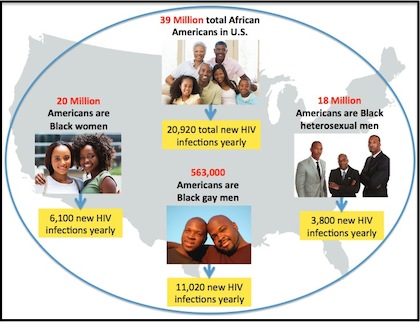 |
| One of the graphics from amfAR’s issue brief |
What factors contribute to the high rates of HIV among black gay and bisexual men? That’s the subject of an issue brief titled HIV and the Black Community: Do #Black(Gay)LivesMatter?
Published by amfAR, The Foundation for AIDS Research, and available for free download, the brief also looks at new data from the Centers for Disease Control and Prevention (CDC) and seeks to put the numbers in a larger historical and social context.
The data is alarming. For example: Although black gay men are only 0.2 percent of the total U.S. population, they account for one in four new HIV infections nationally. Similarly, black gay men are only 1.4 percent of the black population, but they account for one in two new HIV infections among black Americans each year.
The report notes that “lack of social support, higher rates of homelessness, and less access to health care each contribute to HIV infection rates among black gay men” and that “there is no doubt that male-to-female transgender individuals, in particular, are at very high risk for HIV infection.” However, the issue brief also points out that “risk behaviors do not explain higher rates of HIV compared to other gay men.”
Looking to the future, the issue brief suggests, we could learn from and build upon the HIV prevention successes among black woman. In addition, it spells out five actions that could help turn around the current situation:
- We need to achieve funding equity within HIV programs.
- We need to invest in data and long-term monitoring of the lives and experiences of black gay men.
- Black families should start a new conversation with and about their black gay sons.
- We need to create more pathways and models of success for black gay men to lead long, happy and fulfilling lives.
- We need to fight against HIV and not against each other.
The report was released to coincide with National Black HIV/AIDS Awareness Day 2015, which was Saturday, February 7.






Comments
Comments